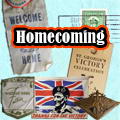Home | World War II | Albertans at War | Going Overseas
Going Overseas
Going overseas was an emotional and traumatic experience for both troops and their respective friends and family. Leaving loved ones behind is never easy; the unpredictability of events in Europe during the Second World War only heightened these and other emotions for all involved. For some men and women who volunteered with the Canadian military, the war in Europe presented an opportunity to attain a steady job and travel abroad. Many agreed that the prospect of regular pay and free accommodation was enough to convince them to join the war effort. However, the same sense of optimism prevalent during the onset of the First World War was not as pervasive during the late 1930s and early 1940s. Much had been learned from the experiences of the First World War. Through media and communications, Canadians were aware of the strength of Hitler’s armies. As a result, there was also a sense of foreboding and a keen awareness of the dangers that lay ahead for many military recruits.
The government of Prime Minister William Lyon Mackenzie King kept Canada's initial expeditionary force small. The 1st Canadian Division (a Division is a large military unit composed of several regiments and brigades), including members of the Loyal Edmonton Regiment, Princess Patricia's Canadian Light Infantry (PPCLI), and the Royal 22e Regiment (the "Van Doos"), were shipped overseas in December 1939 to commence training in Aldershot, England. Two additional regiments would be sent in the coming months to strengthen Canada's military presence in England. Support for the troops and the war effort in Alberta was steadfast and strong. Two of Alberta's long-standing militia, or reserve, infantry regiments, the Loyal Edmonton Regiment and the Calgary Highlanders, each consisting of 2,000 troops, were assigned to both the 1st and 2nd Canadian Divisions. In May 1940, the South Alberta Regiment (SAR) was mobilized to active service. Two years later, the SAR was converted from an infantry unit to an armoured regiment and landed in France in July 1944 as part of the 4th Canadian Armoured Division. Calgary’s Lord Strathcona’s Horse Regiment was mobilized in July 1940. Following several reorganizations during 1940, the unit became part of the Royal Canadian Armoured Corps later that same year. Two years of training prepared the Strathconas for action in Italy beginning in 1943. The regiment was transferred to northwest Europe in February 1945, joining the main Canadian contingent during the Allies' last major thrust of the war—a thrust that resulted in Germany’s surrender.
 For the better part of four years, Canadian troops in Britain trained daily in anticipation of what came to be known as “D-Day”: 6 June 1944. Training was necessary as Canada’s fighting troops were ill-equipped and lacking in experience. The ease with which Hitler’s forces conquered Poland, France, Belgium, and other countries throughout 1939–40 clearly demonstrated that enthusiasm and outdated tactics were no match for a well organized and disciplined military machine boasting tanks, artillery, aircraft, and well-armed ground forces.
For the better part of four years, Canadian troops in Britain trained daily in anticipation of what came to be known as “D-Day”: 6 June 1944. Training was necessary as Canada’s fighting troops were ill-equipped and lacking in experience. The ease with which Hitler’s forces conquered Poland, France, Belgium, and other countries throughout 1939–40 clearly demonstrated that enthusiasm and outdated tactics were no match for a well organized and disciplined military machine boasting tanks, artillery, aircraft, and well-armed ground forces.
At times the training was monotonous and tedious and clearly was not what many had anticipated. Days were filled with marches, physical fitness and endurance tests, battle tactical drills, dummy and live fire exercises, and schooling in skills training—driving, shooting, first aid, mechanics, radio operation, equipment operation, and so forth. Coupled with adjusting to a maritime climate (damp, wet, and often overcast) and shortages of all kinds, not to mention local customs, senior military personnel had their hands full keeping a growing body of men focused and out of trouble.
 Anxious to prove themselves, Canadian troops were involved in some early missions, but most of these did not meet with much success. Their involvement in the failed attempt to secure the French coastal city of Dunkirk during the German invasion of France and the disastrous Raid on Dieppe in 1942 was indicative of how the war effort went for the Allies during the early months and years of the conflict.
Anxious to prove themselves, Canadian troops were involved in some early missions, but most of these did not meet with much success. Their involvement in the failed attempt to secure the French coastal city of Dunkirk during the German invasion of France and the disastrous Raid on Dieppe in 1942 was indicative of how the war effort went for the Allies during the early months and years of the conflict.
Failed or abandoned missions seemed to be the early theme for Canadian soldiers heading overseas. When Hitler attacked Scandinavia, Britain responded with an attempted counterattack through northern Norway. General Andrew G.L. McNaughton, the Canadian commander, organized 1,300 men from the Loyal Edmonton Regiment and Princess Patricia's Canadian Light Infantry (PPCLI) and boarded a train to Scotland. The men were issued winter gear for the mission in Norway. Much to the chagrin of the Canadian troops, the mission was abruptly cancelled and McNaughton was ordered to return to Aldershot and to send Canadian troops into France to support British troops in Dunkirk. Canadian troops were stationed in Dover, England, anxious to cross the Channel. McNaughton visited the situation in France and deemed the mission an unavoidable failure. Known as "The Dover Dash", Canadian troops were promptly sent back to Aldershot.
Reference
Granatstein, J.L. and Morton, Desmond. Canada and the Two World Wars. Toronto: Key Porter Books, 2003.








